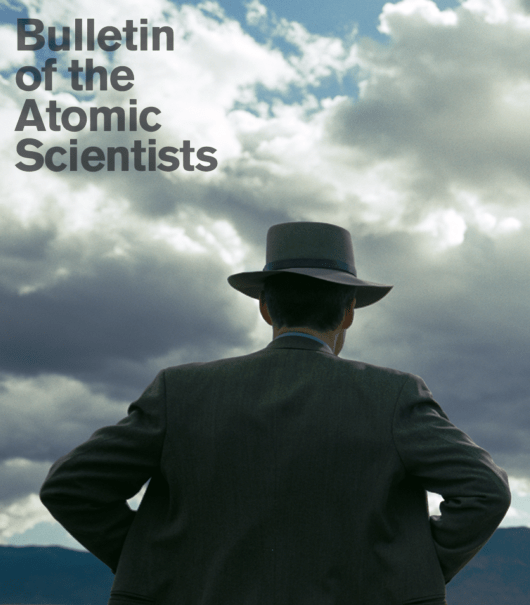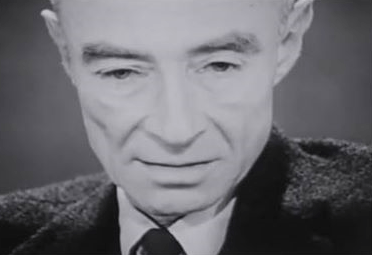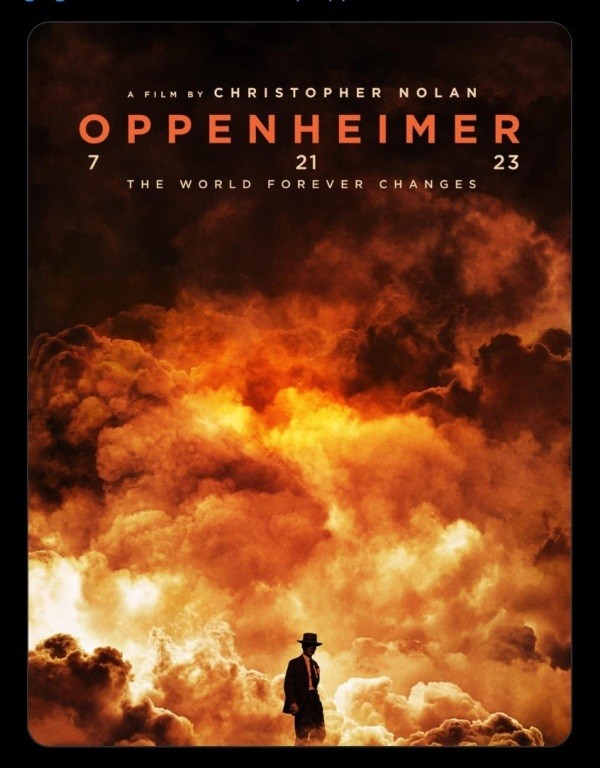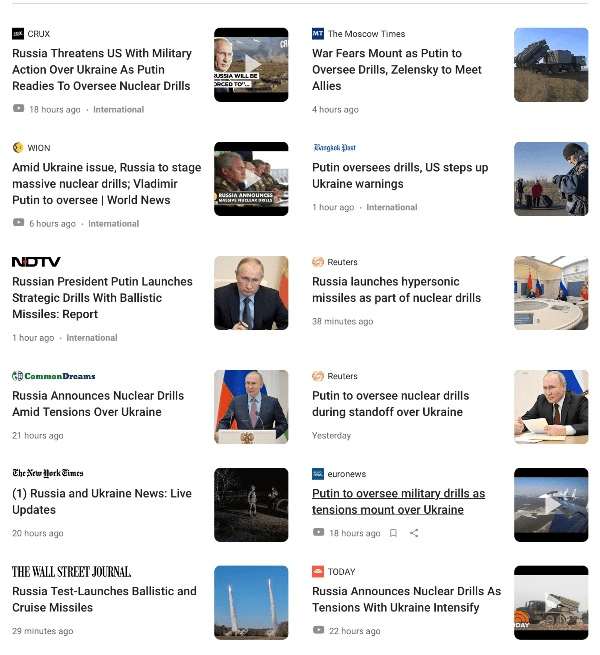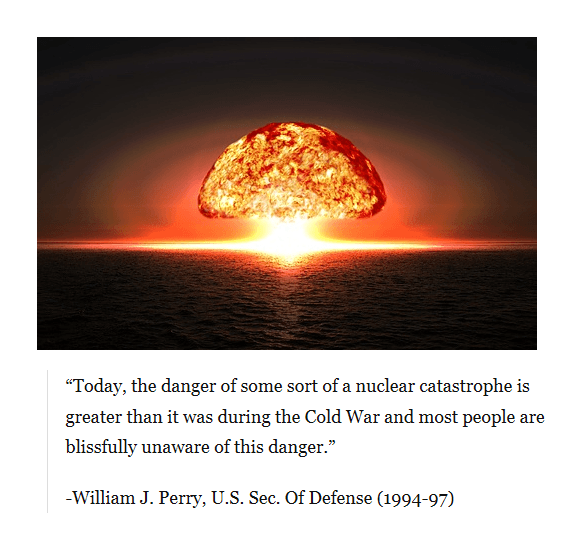
U.S. nuclear national laboratories at Los Alamos and Sandia in New Mexico are the world’s foremost facilities for the production of mass destruction and death… Over the past 60 years, our country has spent over $7 trillion to generate 70,000 nuclear warheads at an average cost of about $100 million apiece… 10,400 such weapons remain today in our nuclear arsenal.
— from remarks by Greg Mello, Director, Los Alamos Study Group, January 6, 2005
StrategicDemands.com:
How close to the Endgame do you think we are? Yes, you. Yes we. We are all in this together whether you agree or not, whether you think of nukes, or care at all, or not. This is not propaganda. The nucthreat, a nuclear threat, nuclear war, an Endgame is there, here, hovering over us.
Strategic and tactical nuclear weapons. Battlefield nukes, bunker-busting nukes, underground lab in mountains destroying, and/or hyperspace delivered nukes, nukes on F-16 and F-35s, cruise-delivered nukes, little nukes, big hydrogen nukes, nukes like the ‘Tsar’ the biggest-of-all-times, and nukes from subs, nukes from silos, nukes from bombers, nukes from strike fighters, nukes from terrorists, nukes from small countries, nukes from large countries, nukes from rogue nations, nukes from nations in and out of the declared nuclear nations…. nuclear conflicts don’t stop their impacts at any nation’s border, regional nuclear conflict, science says, will bring on nuclear winter…. ‘tactical’, ‘smart nukes’, precision-guided missiles tracking targets to within a few meters… or ‘small’ nukes in suitcases, nukes that can be smuggled into ports, on ships…
Nuclear weapons are said by some nuclear weapons believers to provide deterrence and security (they don’t) and that nuclear weapons, large and small and in-between, can bring ‘non-proliferation’ (they don’t), but the harsh reality is nukes are not ‘solutions’…. the promise of nuclear weapons providing security is an illusion.
As we see a Cold War 2.0 heating up with a 3.0 nuclear arms race, the stewards of the nuclear weapons go about their business. In 2023, we are watching a war in Ukraine threaten to set off a nuclear crisis. Will a miscalculation or ‘preemptive’ action cause a ‘fire on warning’ nuclear exchange in Europe, then by auto-command ala a ‘gone mad’ system prove to be the fatal mistake?
Nations are racing to develop next-generation nuclear arsenals as they ‘steward’ nuclear weapons capable of ending civilization as we know it. Here at Strategic Demands we are witnessing what Daniel Ellsberg, a nuclear war planner, wrote of as ‘Doomsday Machine’ war-game plans. These legacies and future plans are grave threats in and of themselves.
“When I came to you with those calculations,” Oppenheimer tells Einstein… “we thought we might start a chain reaction that might destroy the entire world.”
“What of it?” Einstein asks.
Oppenheimer: “I believe we did.”
J. Robert Oppenheimer
“I am become Death, the destroyer of worlds”
Oppenheimer, the Movie (2023)
The business of ‘the Bomb’ begat at Trinity in 1945
Ω
Alpha-Omega: Surviving in a Nuclear Weapons Age
Strategic Demands Editor:
In 2010, three years after the start-up of the Strategic Demands’ “Surviving Victory” project, a newly elected Obama administration submitted its plans for the future of U.S. nuclear weapons.
Earlier the president had spoke in front of the United Nations: “We will complete a Nuclear Posture Review that opens the door to deeper cuts and reduces the role of nuclear weapons.”
In 2009 the U.S. president went farther and spoke of ending nuclear weapons. The world took notice: “I state clearly and with conviction,” Obama said, of “America’s commitment to seek the peace and security of a world without nuclear weapons.”
He told his audience that America, as the only country to have used nuclear weapons, “has a moral responsibility to act.”
Obama called for “concrete steps,” including reducing the role of nuclear weapons in US national security strategy and urging other nuclear weapons states to do the same, reducing the number of nuclear weapons in its arsenal, working aggressively for US ratification of the Comprehensive Test Ban Treaty, seeking a new treaty to end production of fissile materials for weapons, strengthening the Non-Proliferation Treaty, creating an international fuel bank to reduce the risks of proliferation, assuring that nuclear weapons will not be acquired by terrorists, and leading an international effort to gain control of vulnerable nuclear materials throughout the world within four years.
The door quickly closed on his plan for nuclear-weapons reduction.
In fact, instead of the President’s promise to turn the U.S. away from nuclear weapons — and omnipresent security threat of nuclear weapons use — became disastrous.
The Congressional Republican party with support from contractors within the military-industrial complex, and one Democrat, Joe Lieberman with his own agenda, pressed the President to expand and ‘modernize’ nuclear weapons. Instead of promises to eliminate and draw down the nuclear weapons arsenal and commence with a new arms control architecture.
The President’s speeches to work toward nuclear weapons disarmament became a vestige of history, and a new era of nuclear weapons development was forced in the US Senate, a political pressuring of the president and a capitulation to ‘modernize’ the nuclear weapons arsenal. Today we are dealing with the consequences, from a proposed trillion dollar plus expansion of nuclear weapons systems and a response from other nuclear-weapons nations to speed up their nuclear systems development.
At Los Alamos, New Mexico, what has been described as a “nuclear priesthood”, those charged with maintaining the essential nuclear weapons designs, capabilities, rituals of use and handling, are now planning for a next generation of nukes. The modernization program includes redesigned ‘smart nukes’ (with precision targeting capabilities), [https://en.wikipedia.org/wiki/Nuclear_weapon_yield adaptable yields] (nuclear weapon warheads that can be ‘dialed-up’ to change explosive yields), and reconfigured delivery systems (e.g., F-35 with cruise missiles.) The ‘chatter’ in strategic expert circles currently goes to enabling a more “flexible response” and ‘tactical’ and ‘strategic’ use. New designed B-61 warheads are in the mix.
StrategicDemands.com has followed the nuclear weapons issues for years and we have to point at the recent decision to anoint the Los Alamos National Lab, whose scientists and officials have been called “the high priests” of the nuclear age, to take over a manufacturing role. The former nuclear manufacturing center, the Rocky Flats plant in Colorado which has been shuttered, becoming a ‘national sacrifice area’ given the residue from its years as the U.S. center of nuclear weapons ‘pit’ (warhead trigger) manufacturing.
Today in the third decade of the 21st century, the Los Alamos-Santa Fe area are being delivered the news of the US government decision to turn Los Alamos into stewardship of the nuclear weapons complex and the manufacturing center of nuclear warhead ‘pits’, i.e. the triggers, cores of the nuclear weapons themselves. This could forever change the Los Alamos-Santa Fe region into another ‘sacrifice area’ in the event of accident or other nuclear results.
Voices are being raised in opposition to the news of next generation nuclear weapons. Strategic Demands has focused on the Los Alamos Study Group, one of the public interest groups who have been bringing oversight expertise to the nuclear work at the National Lab since 1990.
In 2021-22, those opposed to a new generation of nuclear weapons are under great pressure as a new nuclear arms race has heated up. A war in Ukraine is identifying new threats of nuclear weapons. New nuclear weapons systems are being tested by Russia, China and the U.S. as nuclear arms control agreements are being dismantled.
These are dangerous times as nuke use is dangled about…
The proliferation of nuclear weapons is a generational legacy we must act to limit now, not pass forward in the form of new, more ‘usable’ nukes.
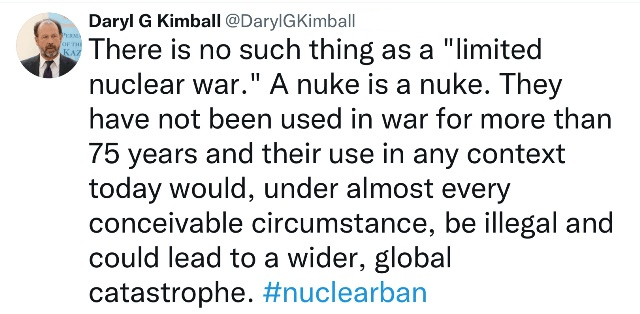
April 2022
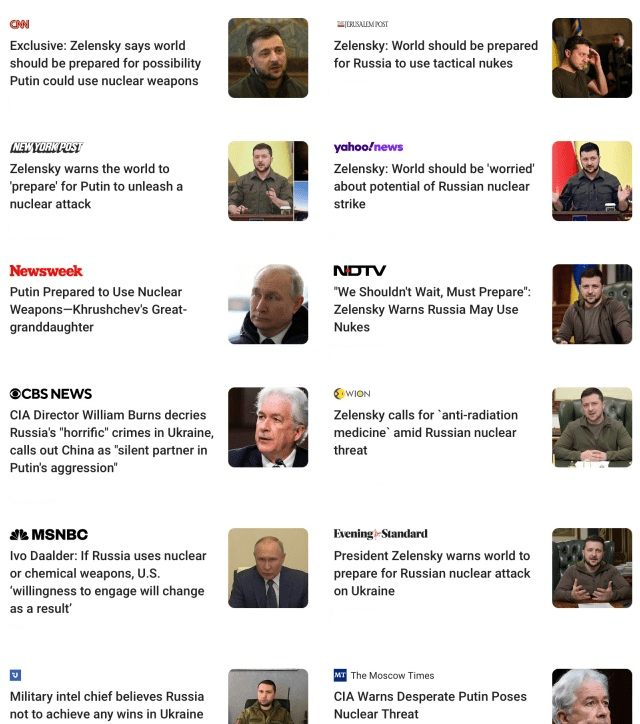
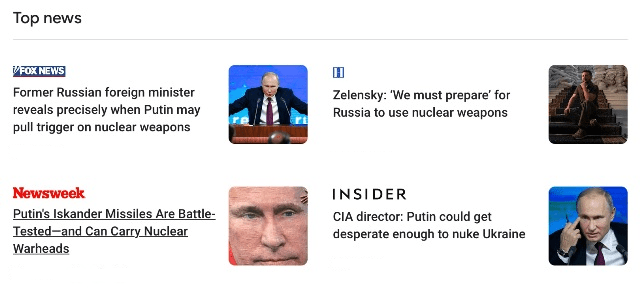
February 2022
February 28, 2022
Washington Post
Opinion: Putin’s nuclear threats remind us arms control is dangerously unfinished business
Lost opportunity for nuclear arms control agreements and ‘mutual security’
The Ukraine-Russia Crisis and Threats of Nuclear Weapons Use
February 24, 2022
Ratcheting Up a “Cold War 2.0”
With the end of the Soviet Union and beginning of the Russian Federation, a 1990’s ‘Peace Dividend’ moment dissipated and was lost to the pages of history
In the 21st Century, we are witnessing a new multi-lateral nuclear arms race
As with the 1950s/60s/70s/80s, we again confront a ‘brim of disaster’ calculus of war
(AXIOS)
Rarely in our lifetimes has the world heard more chilling and ominous words: Vladimir Putin said nations “will face consequences greater than any you have faced in history” if they interfere in his invasion of Ukraine.
Why it matters: This is a rare overt threat of nuclear attack…
Putin said in announcing the invasion:
To anyone who would consider interfering from the outside: If you do, you will face consequences greater than any you have faced in history. All relevant decisions have been taken. I hope you hear me.”
(CNN)
After Russian President Vladimir Putin announced he had ordered military action in Ukraine early Thursday, he threatened “those who may be tempted to intervene” on Ukraine’s behalf.
“Now a few important, very important words for those who may be tempted to intervene in ongoing events from the outside,” Putin said. “Whoever tries to interfere with us, and even more so to create threats to our country, to our people, should know that Russia’s response will be immediate and will lead you to such consequences as you have never experienced in your history. We are ready for any development of events. All necessary decisions in this regard have been made. I hope that I will be heard.”
(NYT)
In a rambling speech early Thursday, full of festering historical grievances and accusations of a relentless Western plot against his country, Mr. Putin reminded the world that Russia “remains one of the most powerful nuclear states” with “a certain advantage in several cutting edge weapons.”
In effect, Mr. Putin’s speech, intended to justify the invasion, seemed to come close to threatening nuclear war.
In the context of Russia’s nuclear arsenal, Mr. Putin said, “there should be no doubt that any potential aggressor will face defeat and ominous consequences should it directly attack our country.”
(POLITICO)
“Suddenly, the ‘unthinkable’ is unfolding before our eyes.” For context, “new deployments of nuclear weapons in Eastern Europe could station US and Russian nuclear weapons closer than at any time in history… this would not be a second Cuban missile crisis but a far more volatile situation.”
(TELEGRAPH UK)
Vladimir Putin appears to threaten nuclear strikes if West launches reprisal attacks
Russian president warns that any attempt to interfere in Ukraine conflict will provoke a response ‘never seen in history’
In a stark reminder of Russia’s nuclear power, he warned that “no one should have any doubts that a direct attack on our country will lead to destruction and horrible consequences for any potential aggressor”.
An Atomic Story
Are the Triggers, the Pits, Inevitable?
Will the Next Generation of ‘Usable Nukes’ Be Built?
By Steven Schmidt / Strategic Demands
The two activists were Buddhists, at least that’s what I thought over the years since they started their work to slow and hopefully stop the nuclear proliferation work of the Los Alamos National Laboratory.
They could see it coming but there was nothing they could do to stop it. They tried to stop it, but the forces were too strong. It was as if they were fighting physics, some sort of physical power that went beyond human. And it did go beyond human. It was atomic.
It was as if someone was trying to stop a chain reaction, and they were on a mission to stop atomic fission set in motion years earlier in 1945. The scientists from the Lab up on a Hill in Los Alamos descended in their old cars and trucks carrying “the Gadget”, as it was known. They were not far from the testing ground south of Albuquerque where they chose to blow up the first atomic bomb. They had built a tower in secret, hoisted the bomb up, wired it and got what they thought was a sufficient distance away in bunkers to watch a dawn explosion. They were unsure what would happen and the night before gambled about whether the atmosphere would catch on fire — or whether the whole thing would be a dud. The sun rose and then those scientists put glasses on, looked out from the bunker, and blew the Gadget up. A flash of thunder announced humanity had entered an “Atomic Age”. A mushroom cloud rose over the Trinity, New Mexico site in the aptly named Jornada del Muerto (“Journey of the Dead Man”). The atmosphere didn’t catch on fire and those bet that it would lost their bets.
Today, in the 2020s, the “Birthplace of the Bomb”, the State of New Mexico. is becoming a worldwide nuclear weapons epicenter
In the city of Santa Fe down the Hill from Los Alamos, and city named after the Catholic patron saint protecting the environment, and the saint whose name was taken up by the current Catholic pontiff known for his environmental advocacy and anti-nuke work, a recent announcement by the U.S. Department of Energy (DoE) and National Nuclear Security Administration (NNSA) has sent warning waves across northern New Mexico and the state capitol in Santa Fe. The government ‘modernization’ plan for the nuclear weapons stockpile will be manufacturing the nuclear weapons cores/pits/triggers at Los Alamos. Los Alamos, the science and design center for the nuclear weapons complex, is now to become the center of the U.S. nuclear weapons production.
The City of Santa Fe to Become a Center of Nuclear Weapons Production?
Two activists in charge of the Los Alamos Study Group, Greg Mello and Trish Williams-Mello, are part of a small contingent of anti-nuclear activists at work these days. They comprise the front lines battling against profoundly consequential decisions they are researching and bringing to public attention. The story they are telling is one of billions of dollars, over a trillion in the coming decades being spent on more nuclear weapons. The story they are telling is one of powerful forces and existential threats, threats that are in reality threatening security in and of themselves. The nuclear weapons race set in motion with modernization, ‘smart’ nuclear weapons, ‘usable’ nuclear weapons, and an array of new delivery systems present a real and present danger.
Want to predict what happens next?

The scientists of the Los Alamos Lab, the ‘Birthplace of the Bomb’, have continued to do their ‘nuclear priesthood’ services since the 1940s, and the Hiroshima and Nagasaki military uses of the first ‘Little Boy’ and ‘Fat Man’ bombs.
Today, the Lab is known locally as a place where Ph.D. scientists and engineers live and do their work. Some point out that the town and its high security buildings house more PH.Ds than anyplace in the world, that it has some of the smartest people anywhere. Others point out that smart can be exceedingly dangerous when untethered from consequences of being too smart for one’s own good. Occasional articles highlight breakthroughs and accomplishments such as when thermonuclear weapons replaced the first-generation bomb. The bomb was described appreciatively in the press as having ‘vastly greater destructive power’ and throughout the 1950s and 60s a first generation, a 1.0, nuclear weapons race between the U.S. and Soviet Union played out with bigger and bigger bombs being tested. Many close calls ensued. The 1962 Cuban Missile Crisis, with its duck and tuck experiences for schools in the U.S. was much too close a call, but it turned out that a Soviet officer saved the day and prevented world war. Few know the name of the insubordinate officer. We do — his name is Arkhipov, Vasily Arkhipov.
The U.S. had been dropping depth charges near the submarine in an attempt to force it to surface, unaware it was carrying nuclear arms. The Soviet officers, who had lost radio contact with Moscow, concluded that World War 3 had begun, and 2 of the officers agreed to ‘blast the warships out of the water’. Deputy Commander (and Flotilla Commander) Vasily Arkhipov refused to agree – unanimous consent of 3 officers was required – and thanks to him, we are here to talk about it.
His story is told in the PBS documentary, ‘The Man who Saved the World‘:
http://video.pbs.org/video/2295274962
Ω
From the 1960s, the Cuban Missile Crisis, until today, when the close call of nuclear world war, of sirens, and a nuclear weapons exchange becomes reality, we have experienced many presidents and (as Strategic Demands updates this Stewards of the Apocalypse site, let’s add a few thoughts
Here’s a compilation of “Apocalyptic Thinking” via StratDems associate:
and here’s a flashback to an Insurrection at the US Capitol in January 2020, recalling a president who refused to leave office after threatening dire consequences to perceived enemies throughout his term in office.
The Donald Trump years produced a string of nuclear boasts and threats:
Donald Trump Elected
More Nuclear Weapons Promises the New U.S. President
“Singular Authority” to launch nuclear weapons
Ω
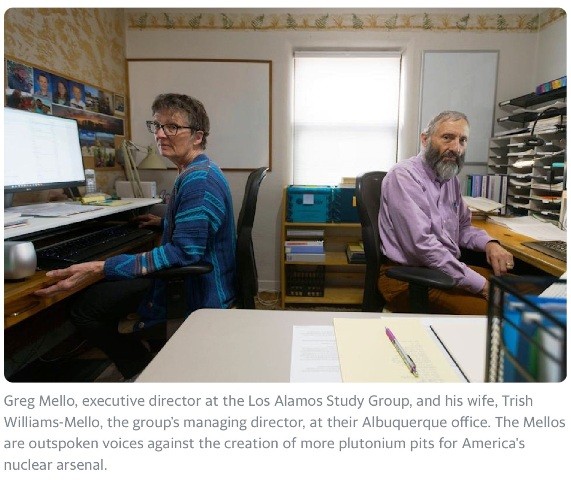
National Sacrifice Area / Nuclear Weapons Consequences
- https://en.wikipedia.org/wiki/Sacrifice_zone
- https://en.wikipedia.org/wiki/Renovation_of_the_nuclear_weapon_arsenal_of_the_United_States
- https://en.wikipedia.org/wiki/Category:Nuclear_weapons_program_of_the_United_States
- https://www.theguardian.com/world/2017/oct/31/us-nuclear-arsenal-cost-cbo-report
- https://en.wikipedia.org/wiki/Anti-nuclear_movement
2010-2018
‘Nuclear Weapons Modernization’: ‘Usable’ Nukes
“Nuclear arsenal modernization” is a multi-decade, trillion dollar plus program that began under U.S. President Trump’s predecessor, President Obama, who negotiated what is, in fact, a new nuclear arms race as the price for nuclear weapons negotiation with the New Start treaty, now in danger of collapsing.
The new nuclear race launched in deadly earnest with a push from the U.S. Senate and delivers evident and rapidly increasing dangers in proliferation as ‘new’ nuclear weapons capabilities and systems, classified for treaty purposes as ‘upgrades’, have resulted in Russian and Chinese countermoves.
As the international community continues advocates for a nuclear weapons reduction and ban, nuclear weapons-holding countries are locking and loading new, more deadly capabilities into their on-alert, launch-on-warning cataclysmic arsenals. The U.S., Russian and China, and a other nuclear weapons possessing countries, are ramping up as we watch.
Contrary to reason, the next generation of nuclear weapons are described as ‘smart’, with new information technologies for ‘precision’ targeting, ‘dial up’ variable nuclear yields whether nuclear-equipped cruise missiles, or guided gravity bombs with newly installed tail-kits.
Tactical nukes are becoming strategic weapons and strategic weapons are becoming tactical in the ‘modernization’ of US nuclear forces. Russia and China have responded with accelerated nuclear weapons programs, tactical and strategic. The latest iteration being hypersonic/hyperspace weapons.
The result of ongoing nuclear weapons modernization, and escalations due to rising geo-political conflict, is a new Cold War era, a multi-nation nuclear weapons expansion led by the US, Russia, and China and accompanied by loud threats and brinksmanship.
The world turns away from nuclear treaties and toward deepening risks as the old ways of escalation and nuclear ratcheting return.
The new version of Cold War, a Cold War 2.0 is a dangerous game.
Let us recall — it is a game of Surviving Victory.
○ ○ ○ ○ ○ ○ ○ ○ ○ ○ ○ ○ ○ ○ ○ ○ ○ ○ ○
“On the Beach: A Flashback”
Stewards of the Apocalypse: An abridged history of U.S. nuclear weapons labs
By Greg Mello
May 18, 2016
What follows is a short and very abridged history of these labs since the Cold War, which will help us understand the political dynamics these labs operate in, how they attained their present grand scale – and what we can do about it. It is adapted from a talk I gave at the New York Academy of Medicine in February 2015 at a symposium sponsored by the Helen Caldicott Foundation entitled “The Dynamics of Possible Nuclear Extinction.”
I tried to tell this story through distinguishable time periods, over the course of which there were about five separate “breakouts,” in which the labs escaped democratic control a bit more each time. In the process there were two major “deals” made with the arms control community, both under Democratic Party presidents. These deals failed to achieve their stated goals and facilitated breakout.
The most significant disarmament occurred during the presidencies of G. H. W. Bush and that of his son G. W. Bush, both Republicans. Obama has done the least for disarmament and the most for modernization.
Administrations change, with apparent novelty and some new slogans. Contractors change occasionally. But at the nuclear labs, there’s enormous continuity as well as change. Beneath the surface, the institutional DNA of the nuclear weapons labs has remained remarkably constant, for decades.
Finally, one cannot understand these laboratories in isolation from related issues. To understand the resurgence of nuclear weapons programs and spending today, it is also necessary to recount the general outline of U.S.-Russian relations in the post- Cold War period. I do that here, in italics. Basically, the neocons made a very successful end-run around nuclear arms control. The extent to which arms control advocates are victims of anti-Russian propaganda is still not much understood in Washington.
Stewards of the Apocalypse: an abridged history of U.S. nuclear weapons labs since 1989
1989-1994: Uncertainty and then downsizing (or “right-sizing”) at the labs. Rocky Flats shutdown and elimination of the Berlin Wall (both 1989). Reciprocal stockpile reductions (to about half of before), bomber de-alerting. Successive failures of DOE plans for a renewed weapons complex. Production site closures (about 80% of facilities). Staff declines (about 1/3 of weapons designers). End of nuclear weapons production after Short-Range Attack Missile (SRAM) workaround. Nuclear test moratorium from 9/92, extended under Sec. O’Leary in 1993 after collapse of stated testing rationales and notional commitment to what became Science-Based Stockpile Stewardship (SBSS). Eileen Welsome Pulitzer-prize reporting on human radiation experiments, O’Leary press conference (12/93). Initiation of the ambitious SBSS program (milestone JASON SBBS report, 11/94); aggressive programs for new nuclear weapons at labs continue to press upwards but fail.
During this period, Cold War triumphalism, which meant more to some factions than others. Leaked Wolfowitz draft Strategic Planning Guidance (1992), at the time seemingly dead in the water. Yeltsin era begins in 1991 (through 1999). Dismantling and collapse of Soviet Union; terrible hardship. Strategic Arms Reduction Treaty II (START II) signed (1993), ratified by Russia in 2000 under Putin, including the condition that U.S. must remain within the Anti-Ballistic Missile (ABM) Treaty.
*
1994-1996: Stabilization and groundwork for growth; new powers to the labs; many new weapons proposed, first new bomb built (B61-11). SBSS begins, the precursor of the broader Stockpile Stewardship and Management (SSM) program. SBSS the result of a political deal for the Comprehensive Test Ban Treaty (CTBT) (“Deal #1”). The Galvin Panel threat to the labs (especially to LLNL and NIF) fended off. Clinton Nuclear Posture Review (NPR) fails under Ash Carter (1994), endorses status quo. SSM Programmatic Environmental Impact Statement (EIS) for weapons complex renewal. Comprehensive JASON 1995 study of stockpile: performance margins for fission primaries are all high enough and can be made higher; JASON issues strong warning against changes. Major effort to include disarmament provisions in Nuclear Nonproliferation Treaty (NPT) led by 120 countries of Non-Aligned Movement nations (NAM) fails in 1995 due to opposition from nuclear weapon states and U.S. arms control funders and NGOs; “Abolition Caucus” of NGOs formed in response. “Stockpile Confidence Symposium” hosted by STRATCOM later in 1995; new weapon candidates briefed to military by labs. First “Submarine Warhead Protection Program” (SWPP) meeting (1995), eventually leading to significant upgrade of W76 fuzing in what is now the W76-1 Life Extension Program (LEP), which as of Feb. 2015 was a little more than half completed. CTBT signed, new “Safeguards” in place with annual warhead certification requirement initiated which gave considerable power, really blackmail power as some understand it, to lab directors. With these changes a new era for labs begins. B61-11 earth-penetrator rapidly created by a field modification (1996) after years of study; it is the first “new” post-nuclear-testing warhead or bomb.
*
1995-2004: Decade of large real annual increases in warhead and lab spending, fully-supported by arms control community as part of CTBT ratification “deal.”
During this period, initial rise of the neocons. Project for a New American Century (PNAC) begins (1997); “Rebuilding America’s Defenses” (2000). Brzezinski, The Grand Chessboard (1997). Clinton turns right on NATO, nukes. Lewinsky scandal, impeachment, Kosovo war (all 1998). NATO expansions (Poland, Hungary, and the Czech Republic in 1999; Estonia, Latvia, Lithuania, Slovenia, Slovakia, Bulgaria, and Romania in 2004); other Russian border states put in NATO “vestibule” pending membership.
*
1997 or 1998: National Defense Authorization Act (NDAA) “reforms” give additional new powers to lab directors and other weapons complex and STRATCOM leaders. Lab directors, who are contractors, now cannot be fired for opinions about stockpile, etc. “Project Sand Dune” (1997), part of stage-setting for new weapons in next administration (a repeating pattern).
*
1999-2000: “Lab Breakout” I, when CTBT ratification (“Deal #1”) fails. The labs just renege on the deal. Wen Ho Lee scandal. Foster Panel reports (these continue through 2003) promoting labs. NNSA created, largely to provide freedom from DOE oversight. PNAC nuclear policy study, which becomes blueprint for initial G. W. Bush nuclear policy.
*
2001-2005: Neocons in power, unprecedented warhead budgets (Breakout II, attempted but only partially successful); plan to make over or replace the entire arsenal in Bush NPR (fails but is successfully reinstated under Obama); Modern Pit Facility (MPF) proposed but fails. This breakout was checked in part by lack of sound purpose, by bipartisan congressional and NGO opposition, and florid, poor management. Half-year LANL security and safety shutdown (2004).
During this period, beginning of continuous global “liquid war” and resulting growing chaos (aka “War on Terror”). U.S. withdrawal from ABM treaty (2002), triggering end of START II (2002). The weak but surprisingly effective Strategic Offensive Reductions Treaty (SORT) signed (2002).
*
2005: Breakout III: physics lab privatization decision (LANS 2006, LLNS 2007). Bechtel-led consortia with only minor corporate differences take over both labs. Lab directors are now interest-conflicted corporate presidents and CEOs. Previous contractor (University of California) was not using the latent power of labs sufficiently. Privatization causes significant reductions in force and lays groundwork for defined-benefit pension crisis in the present decade. Warhead budgets begin falling in real terms as the cost of new wars weighs down the military budget and tax cuts are enacted. Reliable Replacement Warhead (RRW) proposed.
During this year (2005): Peak conventional (i.e. cheap) oil appears, in the form of an “undulating plateau” of production. Net oil exports peak worldwide, peak oil per capita and peak oil per dollar GDP all pass into history, initiating a new era of incipient scarcity. Oil and gas geopolitics in all their forms enter a fraught new period, with Russia near or at the top of oil export rankings and Europe highly and increasingly dependent on Russian gas.
*
2006-2008: Relative stability at the labs amid the growing turmoil about performance; budgets sag in real terms and operational costs soar. RRW dies. New plans laid; but global financial crisis. GW Bush retires half of nuclear arsenal (2007), fulfilling SORT commitment 5 years early.
During this period, Putin speech in Munich reviews history of arms control, drawing line, halting Russian weakness toward U.S. and NATO (Feb. 2007). Russo-Georgia war (2008).
*
2009-2010: Breakout IV: the “Prague Deception,” Nobel rumors (in February), then the Prague speech in April, then the prize. December 2009 love-fest with lab directors at White House; administration commits to wider role for nuclear labs in homeland security, intelligence and DoD, later visible in interagency charter of July 2010 immediately preceding New START endorsement by lab directors, plus also $1 trillion comprehensive DoD/DOE nuclear modernization commitment, plus also a New START without significant disarmament (with more warheads at higher readiness in the reserve arsenal than before). Vague NPR issued with differing interpretations. This whole package is “Deal #2.”
During this period, Albania and Croatia join NATO (2009).
*
2011-2013: Modernization falters. Flagship project Chemistry and Metallurgy Research Replacement Nuclear Facility (CMRR-NF) paused by litigation then fails from lack of need, wasting $500 million; fiasco continues to now [2016]. Uranium Processing Facility (UPF) at Y-12 site in Oak Ridge stumbles and is dramatically downsized and redesigned, also wasting a half-billion or more dollars. At this point, every large NNSA and DOE project is in trouble. Budget Control Act (BCA) sequestration limits modernization “takeoff,” given the highly wasteful institutional environment.
During this period, direct U.S. involvement in U.S.-abetted and U.S.-ally-funded Syria war, sought by neocons since 2003 and before, averted at last minute (2013). Pentagon approves possible nuclear reduction of one-third, which isn’t implemented in part due to political conditions associated with Deal #2. Yalta (Crimea) conference about the (European) future of Ukraine and Crimea, including both Clintons and former DOE Sec. Richardson, who promises that fracking will provide natural gas independence for Ukraine from Russia.
*
2014: Breakout V: massive warhead budget liftoff at last, Obama disarmament hopes ended. But also some significant retrenchment and delays in stockpile management goals. Nuclear moderate Asst. DoD Sec. Andrew Weber fired by Obama; nuclear war-fighting mentality slips the leash. Old-fashioned “public service” fee model for labs floated by NNSA given poor performance under profit motive. “Interoperable” warhead delayed indefinitely at end of year or beginning of 2015, effectively ending (lab-written) “3 + 2” stockpile plan in all but name, but LRSO schedule moved up 3 years. LANL idiocy shuts down WIPP indefinitely due to scientific, management error incurring $500+ million in costs. DOE withholds all LANL fee, shortens contract by two years. Latest reform committees stumble forward fecklessly. NNSA called “failed experiment” but nothing is done.
During this period, U.S.- and other launch violent “color revolution” (“Maidan” coup d’etat), to bring Ukraine into the Western economic and political orbit which would drastically weaken Russia and seize Russia’s warm-water Black Sea port of Sevastopol, culturally and militarily part of Russia since Catherine the Great.. The new Ukraine government initiates civil war. Neo-Nazi violence grows. Russia accepts Crimea back after fair, highly-lopsided vote, without violence, frustrating neocon plan. Economic sanctions against Russia, plus a currency attack. And so arms reductions likely end under Obama before they begin.
*
2015-2016: continued robust budget growth, shorter warhead modernization deadlines, required design and prototyping of new warheads.
Meanwhile, Russia makes itself indispensable in Syria and as regards Iran, strengthens its military, elevates its nuclear command, establishes large, capable National Guard force, and continues nuclear modernization. Ukraine now seems a bigger problem for Europe. NATO forces strengthened dramatically across the Eastern Europe. Plans for big NATO navy base at Odessa. Cold War II well underway.
*
How shall we summarize this history of the labs? I would say:
- There have been 25-plus years of crises and fiascos, punctuated by periods of apparent relative stability (or lack of visibility of problems). During most of this time, budgets have grown.
- We have seen continuous active and passive support for nuclear labs by the arms control community, by Democrats as well as Republicans, right down to present day. Fantasies of “diversification,” “conversion,” and “cleanup” are used to bring in donors and Democratic Party voters. This is highly counterproductive.
- Ever-more-sophisticated modes of public relations, political control, and propaganda are being used by these labs nationally as well as regionally. Mere existence at scale and continued funding largesse, without accountability, are now considered essential elements of the U.S. nuclear “deterrent,” independent of any products, milestones, or logic.
- Approximately 55 studies of DOE lab reform were conducted from 1994-2014. Some are ongoing now [in 2015], all with little or no success. GAO has kept DOE and now NNSA large project management on its “high risk” list for waste, fraud, and abuse since the early 1980s. As a result of this and other factors, long survival of a functioning warhead complex is not assured. The great funding success of the warhead complex has also made it inefficient and internally weak. It is something of a stuffed goose.
- Across this span of time the labs have gained power, but also squandered the same in poor management. Funding is higher but so are salaries; employment remains near Cold War levels.
- A workload and mission crisis looms at LANL and LLNL especially, despite Herculean efforts by all three labs to broaden their missions. If new warheads are not funded the crisis will become general across the complex in the 2020s. New forms of hybrid war, and homeland security, have become a successful new business for SNL.
What prospect, then? Expanding our lens as at the beginning of this talk, we find ourselves in a new era, almost a discontinuity in history across many fronts. The common quality of these changes is increasing constraint on the choices available. A Churchillian “period of consequences” has begun. But please note, these constraints also act on the nuclear warhead enterprise, which faces headwinds it finds mysteriously potent.
To conclude, we face a number of risks, including:
- Nuclear war, the risk of which is high and growing. There are already, or soon will be, fundamental material sources of conflict between nuclear armed states. By contrast the Cold War had a predominately ideological character.
- Catastrophic climate change. Should we continue policies of nuclear deterrence on a grand scale, in a matrix of militarism sufficient to support it, we will be unlikely to address climate deterioration. Only economic collapse might save us.
- Resource limitations, particularly of oil. These limitations are sharp and growing beneath the surface, despite apparent market gluts, themselves created by the end of growth, lack of purchasing power, debt saturation, etc. “Demand destruction” is a matter of geography and economic class. The race for resource dominance and related geopolitical position is the single most potent motivator of U.S. wars in this century.
- Crises of capitalism, imperialism, and legitimacy of governance are now pervasive and linked. They are beginning to escape control, and as a result certain truths are no longer told in elite media. The mountain of misinformation (Robert Parry) is growing. Propaganda saturates decision-making circles, which are increasingly blind.
In such a situation we have very little to lose by boldness, and everything to lose by incrementalism. When a centrist former Secretary of Defense (William Perry) argues that the U.S. has no need for either ICBMs or new cruise missiles, we should sit up and pay attention. Why is the Air Force in the nuclear business at all? The answer to that question is not “nuclear deterrence.”
There will be no wide or deep political support for discussions of how many of our nuclear demons will fit on the head of a pin. We should be aiming at deep cuts and major changes in policy, not 10% trims.
We need to advocate for slashing lab budgets and we need to attack the legitimacy of nuclear weapons themselves. This, as part of a broader turning of our society away from militarism, empire, and war, toward human solidarity and stewardship of our precious, fragile earth.
An Ominous Thought, Flashforward
William J Perry
https://strategicdemands.com/what-are-the-odds/
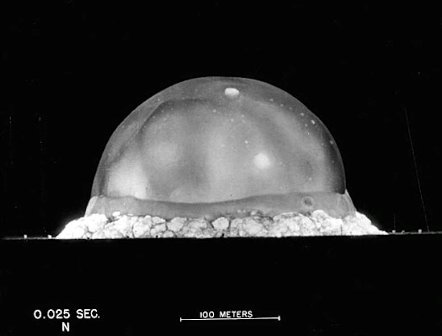
A few people laughed, a few people cried… most people were silent
https://www.greenpolicy360.net/w/File:Oppenheimer_–_the_2023_movie_and_in_the_1940s.png
Dan Kois (Slate): The centerpiece of the movie is the first Trinity test… How does a typical bomb in 2023 compare in strength to that test?
Seth Shelden (United Nations Liaison for the International Campaign to Abolish Nuclear Weapons): The average bomb in one of the U.S. arsenals, let’s say, is somewhere between five times and 30 times bigger than what was used in the Trinity test, which was the same size as the Hiroshima bomb. We have some in our arsenal that are over a megaton, so 80 times bigger than what we dropped in Hiroshima. The largest weapon that’s ever been tested, I think it’s over 3,000 Hiroshima bombs. That’s the Tsar Bomb. It shattered windows in other countries when it was tested.
The basic answer is that the weapons that were used in New Mexico — and in Hiroshima and Nagasaki, which killed hundreds of thousands of people — look like colonial muskets by comparison to what we have now.
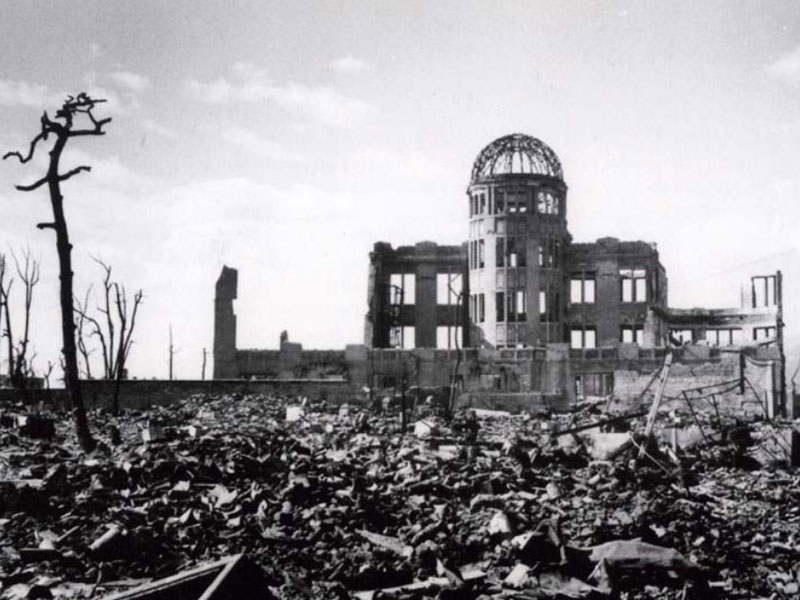
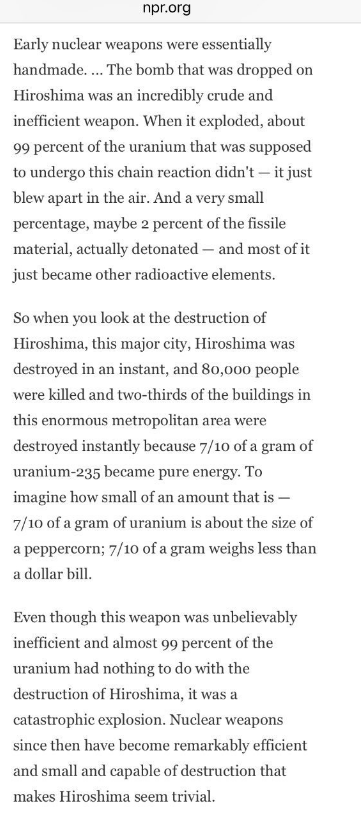
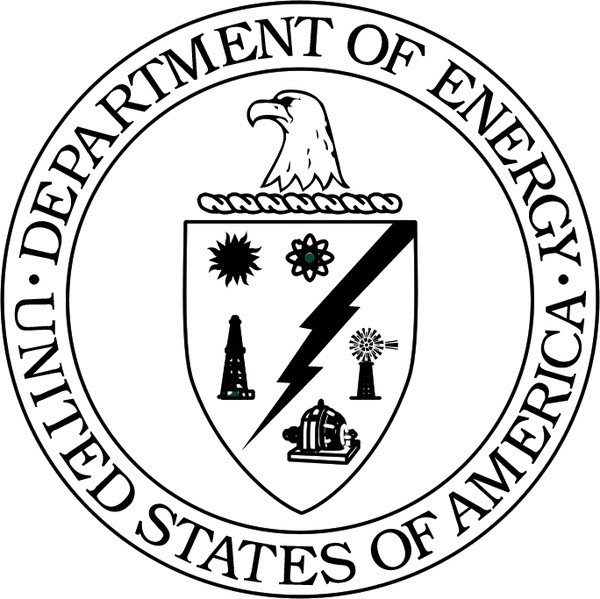
♠

